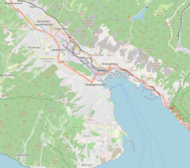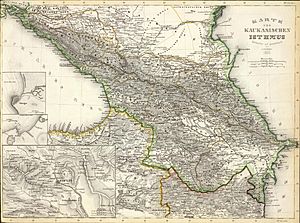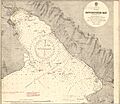Novorossiysk facts for kids
Quick facts for kids Novorossiysk (English)Новоросси́йск (Russian) |
|
|---|---|
| - City - | |
 |
|
|
|
|
| City Day | September 12 |
| Administrative status | |
| Country | Russia |
| Federal subject | Krasnodar Krai |
| Administratively subordinated to | City of Novorossiysk |
| Administrative center of | City of Novorossiysk |
| Municipal status | |
| Urban okrug | Novorossiysk Urban Okrug |
| Administrative center of | Novorossiysk Urban Okrug |
| Mayor | Andrey Kravchenko |
| Statistics | |
| Area | 81.1 km2 (31.3 sq mi) |
| Population (2010 Census, preliminary) |
241,952 inhabitants |
| - Rank in 2010 | 76th |
| Density | 2,983/km2 (7,726/sq mi) |
| Time zone | MSK (UTC+04:00) |
| Founded | 1838 |
| Postal code(s) | 353900–353903, 353905–353907, 353909–353913, 353915–353925, 353960, 353999 |
| Dialing code(s) | +7 8617 |
| Official website: http://admnvrsk.ru/ | |
Novorossiysk (Russian: Новоросси́йск) is a large city in Krasnodar Krai, Russia. It is located on the Black Sea coast. Novorossiysk is famous for having one of the biggest ports on the Black Sea. It is also one of the special cities in Russia known as a Hero City. This title was given to cities that showed great bravery during World War II.
About 262,293 people live in Novorossiysk as of 2021.
Contents
History of Novorossiysk
In ancient times, the area around Novorossiysk was home to an old Greek settlement called Bata. This colony was important for trading grain. Later, the area was controlled by the Romans and then the Khazars.
Around the 9th century, it became part of the Byzantine Empire. In the 11th century, nomads from the Eurasian plains took over. Interestingly, some Anglo-Saxon refugees from England settled here. They might have even named a port Susaco, possibly from "Sussex."
In the 15th century, traders from Genoa, Italy, had a trading post here. Later, in 1722, the Ottoman Empire built a fortress called Sujuk in the bay.
Founding the City
In 1829, Russia gained control of the coastline after a war with the Ottoman Empire. In 1838, Russian admirals Mikhail Lazarev and Nikolay Raevsky founded a naval base here. They named it Novorossiysk, which means "New Russia." This port was a key part of a chain of forts along the Black Sea coast.
Novorossiysk grew quickly in the 19th century. It became a city in 1866. In 1905, it was briefly the center of a small, independent area called the Novorossiysk Republic.
World War II and Hero City Status
During World War II, German and Romanian armies occupied most of Novorossiysk in September 1942. However, a small group of brave Soviet sailors defended a part of the city called Malaya Zemlya for 225 days. Their heroic defense prevented the enemy from using the port for supplies. The Red Army finally freed the city in September 1943.
Because of its incredible bravery during the war, Novorossiysk was given the title of Hero City in 1973. The famous composer Dmitri Shostakovich even wrote a piece of music called Novorossiysk Chimes to honor the city.
In 2003, Russian President Vladimir Putin decided to build a new naval base for the Black Sea Fleet in Novorossiysk. This base is very important for Russia's navy.
City Administration
Novorossiysk is an important administrative center in the Krasnodar Krai region. It includes the main city and 24 smaller rural areas. Together, they form what is called the Novorossiysk Urban Okrug.
Coat of Arms of Novorossiysk
The city's coat of arms has changed a few times over the years. The current design was approved in 2006. It features a golden shield with a black wavy line at the bottom. Above this line is a black double-headed eagle wearing an Imperial crown. The eagle holds a scepter and a power symbol. On its chest is a red shield with a golden Orthodox cross above a silver crescent moon.
- Coats Novorossiysk
Geography and Climate
Novorossiysk is located right on the Black Sea. While it's not a typical beach resort, nearby cities like Anapa and Gelendzhik are popular tourist spots. One famous area near Novorossiysk is Abrau-Dyurso. It has a town by Lake Abrau and a village on the Black Sea coast.
The region around Novorossiysk is also known for growing grapes and making wine. The wineries of Abrau-Dyurso have been making wines since 1870.
Weather in Novorossiysk
Novorossiysk has a climate that is a mix of humid subtropical and Mediterranean. This means it has warm, humid summers and mild winters. Sometimes, the driest month might not always be in summer.
| Climate data for Novorossiysk (1936-1987) | |||||||||||||
|---|---|---|---|---|---|---|---|---|---|---|---|---|---|
| Month | Jan | Feb | Mar | Apr | May | Jun | Jul | Aug | Sep | Oct | Nov | Dec | Year |
| Record high °C (°F) | 22.8 (73.0) |
21.0 (69.8) |
25.0 (77.0) |
28.0 (82.4) |
31.8 (89.2) |
38.0 (100.4) |
39.0 (102.2) |
36.1 (97.0) |
34.0 (93.2) |
30.0 (86.0) |
28.0 (82.4) |
25.0 (77.0) |
39.0 (102.2) |
| Mean daily maximum °C (°F) | 6.1 (43.0) |
6.5 (43.7) |
9.7 (49.5) |
15.0 (59.0) |
19.6 (67.3) |
24.1 (75.4) |
27.6 (81.7) |
27.7 (81.9) |
23.1 (73.6) |
17.2 (63.0) |
12.7 (54.9) |
8.8 (47.8) |
16.5 (61.7) |
| Daily mean °C (°F) | 2.9 (37.2) |
3.6 (38.5) |
6.3 (43.3) |
11.5 (52.7) |
16.2 (61.2) |
20.5 (68.9) |
23.8 (74.8) |
23.5 (74.3) |
18.9 (66.0) |
13.4 (56.1) |
9.4 (48.9) |
5.9 (42.6) |
13.0 (55.4) |
| Mean daily minimum °C (°F) | −0.2 (31.6) |
0.5 (32.9) |
3.1 (37.6) |
8.2 (46.8) |
12.9 (55.2) |
16.9 (62.4) |
20.0 (68.0) |
19.7 (67.5) |
15.1 (59.2) |
9.8 (49.6) |
6.2 (43.2) |
2.8 (37.0) |
9.5 (49.1) |
| Record low °C (°F) | −18.0 (−0.4) |
−17.0 (1.4) |
−12.2 (10.0) |
−5.0 (23.0) |
−1.1 (30.0) |
2.0 (35.6) |
8.0 (46.4) |
10.0 (50.0) |
4.7 (40.5) |
−2.0 (28.4) |
−6.1 (21.0) |
−13.0 (8.6) |
−18.0 (−0.4) |
| Average precipitation mm (inches) | 125.6 (4.94) |
76.6 (3.02) |
104.7 (4.12) |
58.6 (2.31) |
41.5 (1.63) |
49.9 (1.96) |
38.5 (1.52) |
50.9 (2.00) |
35.9 (1.41) |
61.0 (2.40) |
61.4 (2.42) |
156.2 (6.15) |
860.2 (33.87) |
| Average precipitation days | 8.6 | 6.9 | 6.8 | 6.3 | 5.3 | 5.0 | 3.6 | 3.2 | 3.6 | 5.0 | 6.1 | 9.4 | 69.8 |
| Source: climatebase.ru | |||||||||||||
| Historical population | ||
|---|---|---|
| Year | Pop. | ±% |
| 1897 | 16,897 | — |
| 1926 | 67,941 | +302.1% |
| 1939 | 95,240 | +40.2% |
| 1959 | 93,461 | −1.9% |
| 1970 | 132,744 | +42.0% |
| 1979 | 159,135 | +19.9% |
| 1989 | 185,938 | +16.8% |
| 2002 | 232,079 | +24.8% |
| 2010 | 241,952 | +4.3% |
| 2021 | 262,293 | +8.4% |
| Source: Census data | ||
Economy and Industry
Novorossiysk is a very important city for Russia's economy. It has a large, ice-free port on the Tsemess Bay. This bay has been known for centuries as one of the best bays on the Black Sea.
Busy Sea Port
The Novorossiysk Commercial Sea Port is a huge business. It helps Russia trade by sea with countries in Asia, the Middle East, Africa, and South America. It's the busiest port on the Black Sea for oil shipments. It's also where a major pipeline from Kazakhstan ends, bringing oil to be shipped out.
Local Industries
Besides being a port city, Novorossiysk has many other industries. These include making steel, processing food, and producing metal goods. There are also many limestone quarries nearby. These quarries supply materials for important cement factories in and around the city. Novorossiysk is also home to the Maritime State Academy and Novorossiysk Polytechnic Institute, where students can learn about shipping and technology.
Transportation in Novorossiysk
Novorossiysk is Russia's biggest seaport. In 2019, it handled over 142 million tons of cargo. By 2021, this was still a huge 105 million tons.
The city is well-connected to other parts of Russia and nearby regions. It has train lines and highways that link it to major cities and industrial areas. The Novorossiysk railway station serves the city.
If you want to fly, there are airports close by. Gelendzhik Airport is about 33 km away, Anapa Airport is 53 km away, and Krasnodar Airport is 172 km away. These airports offer flights to many cities across Russia.
Sports and Recreation
The city has a football team called FC Chernomorets Novorossiysk. They play in the Russian second division.
Places to Visit
- Novorossiysk TV Tower
- Shopping Mall "Krasnaya Ploshchad"
- "Lenin's" Amusement Park
- Malaya Zemlya Memorial, which honors the brave sailors of World War II.
Famous People from Novorossiysk
Many interesting people have come from Novorossiysk, including:
- Seitumer Emin (1921 – 2004), a writer and activist.
- Ida Nudel (1931 – 2021), an activist from Israel.
- Eugene Kaspersky (born 1956), who founded the famous computer security company Kaspersky Lab.
- Emir-Usein Kuku (born 1976), a human rights defender.
- Eduard Sarkisov, a football coach and former player.
- Georges Gurvitch, a Russian-French sociologist and philosopher.
- Viktor Petrovich Skarzhinsky (1787 – 1861), a landowner and forester.
Sister Cities Around the World
Novorossiysk has special connections with many cities in other countries. These are called sister cities. They work together on cultural and educational projects.
|
Images for kids












